Premier League finally returns. After Bundesliga being the first league to return, followed by La Liga last week, England’s top-flight competition joined the party with their Project Restart. To be fair, the return started exceptionally. A hugely controversial event at the Villa Park just hours prior marked the return of the most followed football league in the world. As expected, this game between Manchester City and Arsenal even produced more drama than the opening match.
The match was the first encounter between seasoned tactician Pep Guardiola, and his protégé Mikel Arteta, after the latter left The Citizens last year. Despite Arteta’s brilliance to match his mentor, Guardiola proved his worth and experience over the 38-year-old. This tactical analysis will unfold what tactics both teams used in the game.
Lineups
Guardiola set his team up in the usual 4–3–3. Promising centre-back Eric García surprisingly was picked to partner Aymeric Laporte in the heart of City’s defence. In front of them, the trio of Kevin De Bruyne, İlkay Gündoğan, and David Silva started in the home side’s engine room. Upfront, Gabriel Jesus led the attacking line with Riyad Mahrez and Raheem Sterling in both flanks. Names like Phil Foden, Bernardo Silva, Sergio Agüero, Rodri, and Fernandinho had to start the match from the bench.
Similarly, Arteta picked his usual formation for his team. However, the shape is 4–2–3–1 rather than 4–3–3. New recruitment Kieran Tierney started as the left-back while Héctor Bellerín started in the opposite flank. The Gunners’ frontline was filled with their exciting young guns. The trio of Bukayo Saka, Joe Willock, and Eddie Nketiah was given the license to help talisman Pierre-Emerick Aubameyang in the forward line. Arsenal’s dugout was filled with players like Dani Ceballos, David Luiz, Ainsley Maitland-Niles, Reiss Nelson, and Alexandre Lacazette.
Let the chess game begin
The first half of this match felt more like a game of chess as both managers keep reacting to each other’s tactics. Let’s start by the home side aggressive pressing system. Initially, Guardiola instructed his team to play in a high-pressing 4–3–3. The objective was to prevent Arsenal from building their play smoothly from the back.
In the process, G. Jesus aggressively pressed goalkeeper Bernd Leno whenever he had the ball. The Brazilian also tried to close Mattéo Guendouzi with his cover shadow to prevent a forward pass to him. City’s wingers joined the press by closing down centre-backs Shkodran Mustafi and Pablo Marí, which later replaced by Luiz due to an injury.
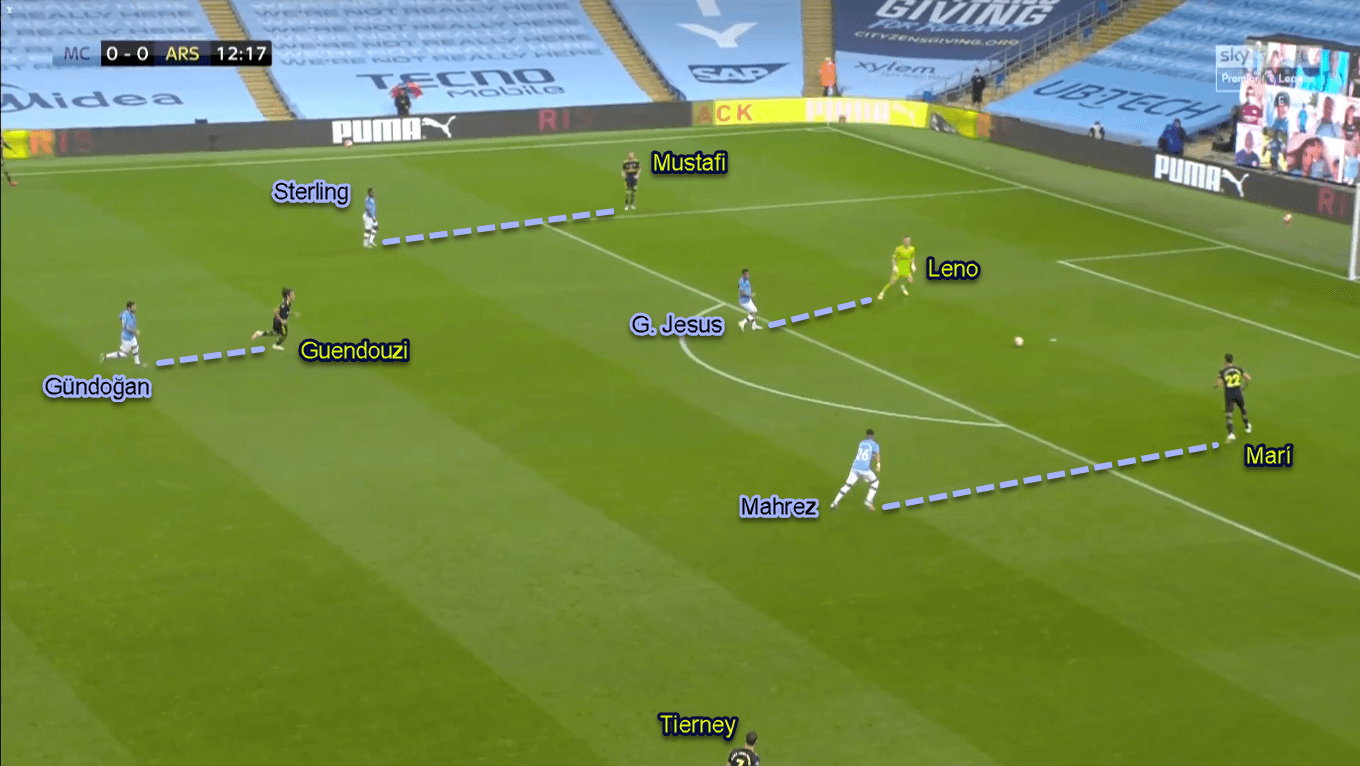
The pressing system didn’t stop there. Behind G. Jesus, Gündoğan stepped up from his initial position to shut Guendouzi down. Alongside the German midfielder, both De Bruyne and Silva were ready to pounce the full-backs if Leno picks that pass. By doing so, City shut all nearby passing options for Leno. This also forced the goalkeeper to deploy ineffective long balls upfront. Looking at the statistics, none of his 10 long pass attempts found its target.
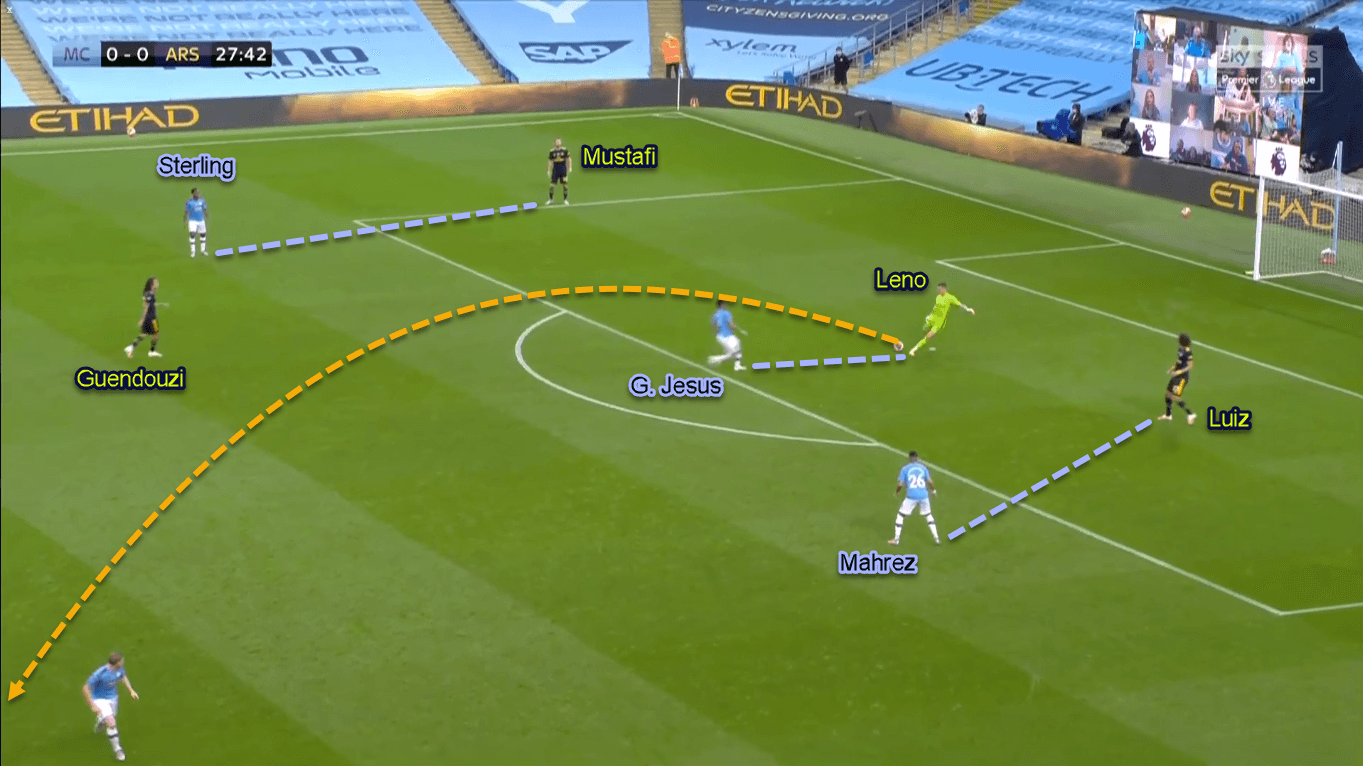
However, the press had an issue. The next part of the analysis will take a look at how Arteta tried to exploit this.
Arteta’s answer to City’s pressing game
One of the most interesting aspects of City’s pressing game was Gündoğan’s role. Instead of staying in his designated zone for most of the time, the German was instructed to step up and close Guendouzi while G. Jesus pressed Leno. It opened a huge space in between City’s lines which sometimes got exploited by Arteta’s armada.
The visitors exploited this also in a calculated fashion. As mentioned before, both De Bruyne and Silva would step out to their respective flank when Leno plays the ball to the full-back. At first, it seemed that City successfully shut down all Arsenal short options. However, it opened a bigger problem for their defence.
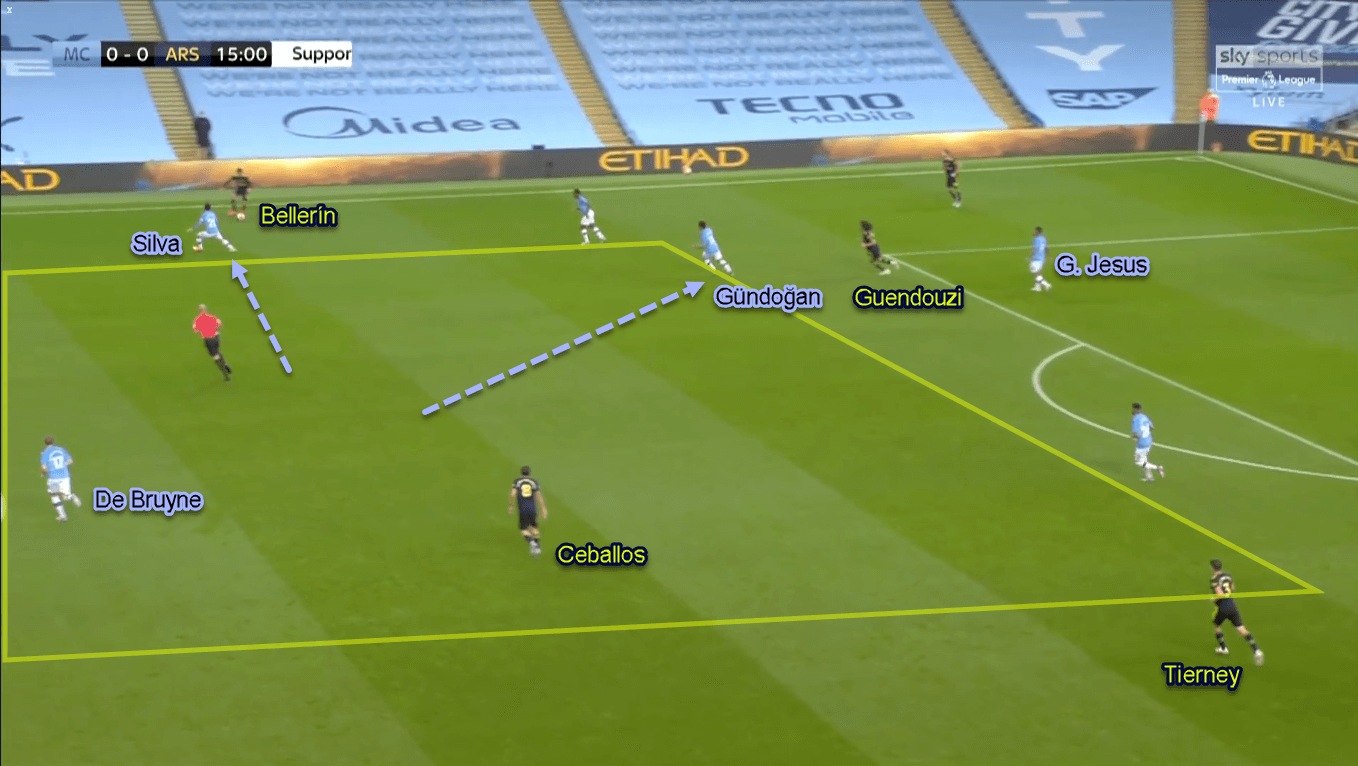
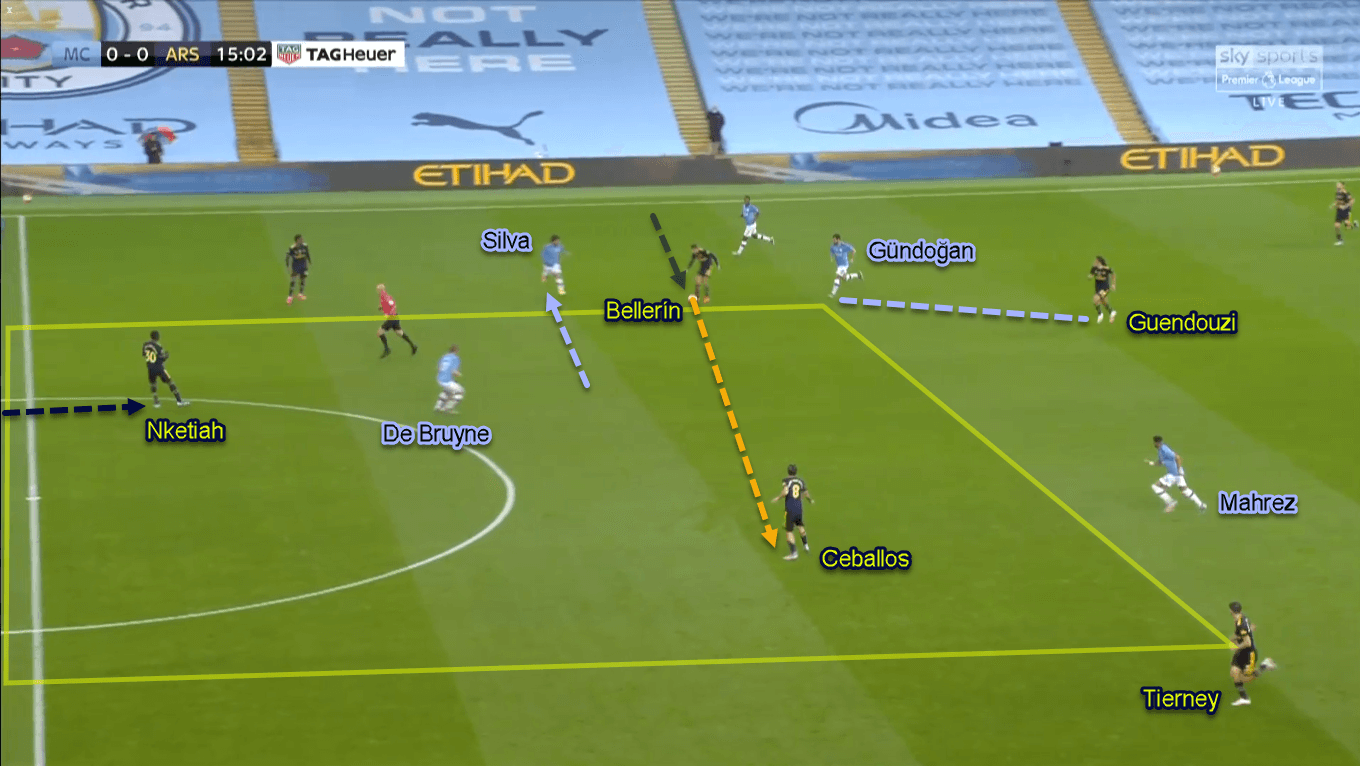
Arsenal started by allowing Leno to send a diagonal ball to Bellerín or Tierney. With Gündoğan already moving out of his position to close Guendouzi, and followed by the ball-side midfielder to step out, City opened a huge space in between the lines. Various Arsenal players could exploit this gap. Either the dropping Nketiah, the midfielders bar Guendouzi, and even the full-backs themselves did enjoy some moments there.
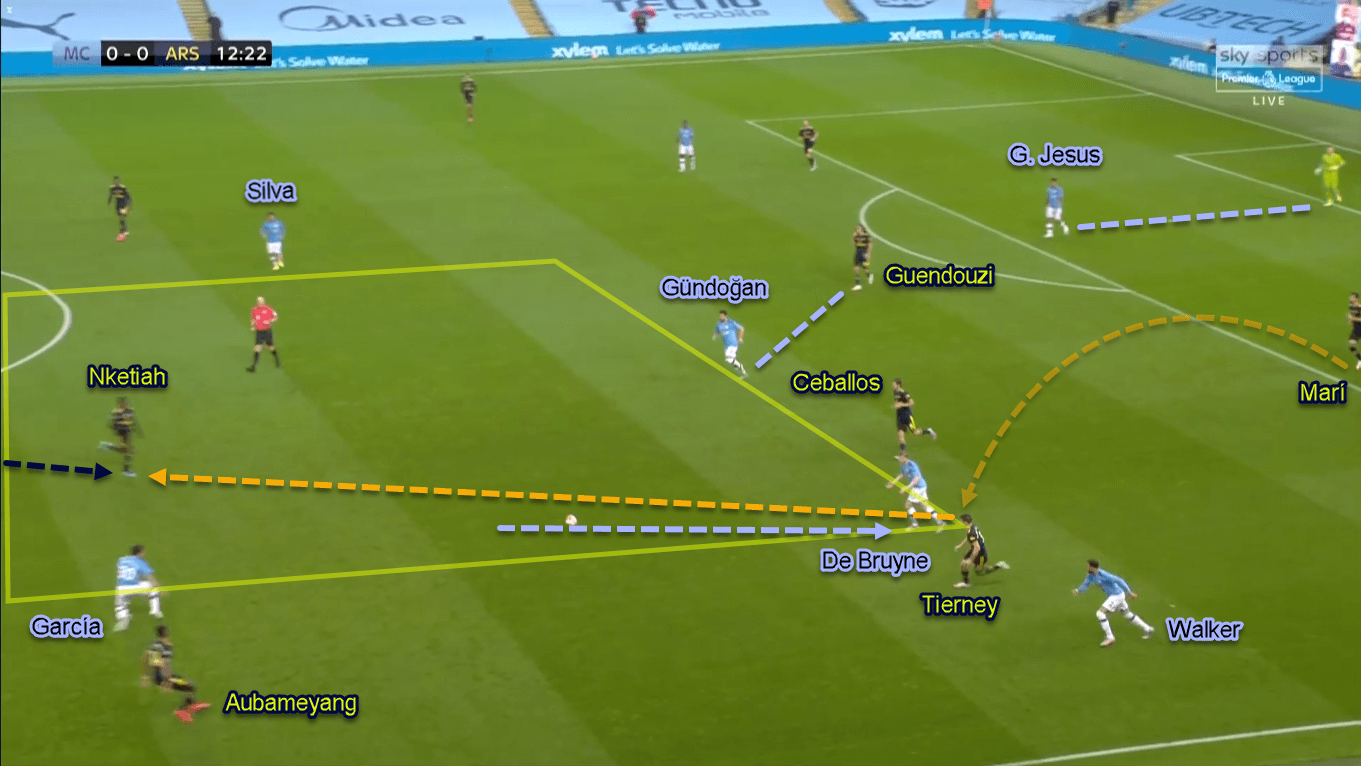
Start smart, but …
To be honest, Arteta did find out the weakness in Guardiola’s pressing system and exploited it to a certain extent. What made his team unable to create more damage was their lack of (quality) service for Aubameyang.
From time to time, the talisman smartly positioned himself in between Kyle Walker and García. Sometimes Aubameyang even only had to face García — attacking the defender’s blind-spot — because Walker was positionally too advanced after joining the attack. With unmatched speed he has, Aubameyang is more than likely to win a footrace in behind. Yet, none of his teammates served him with tasty through-balls in behind. Even if they did, the service was rather poor in quality.
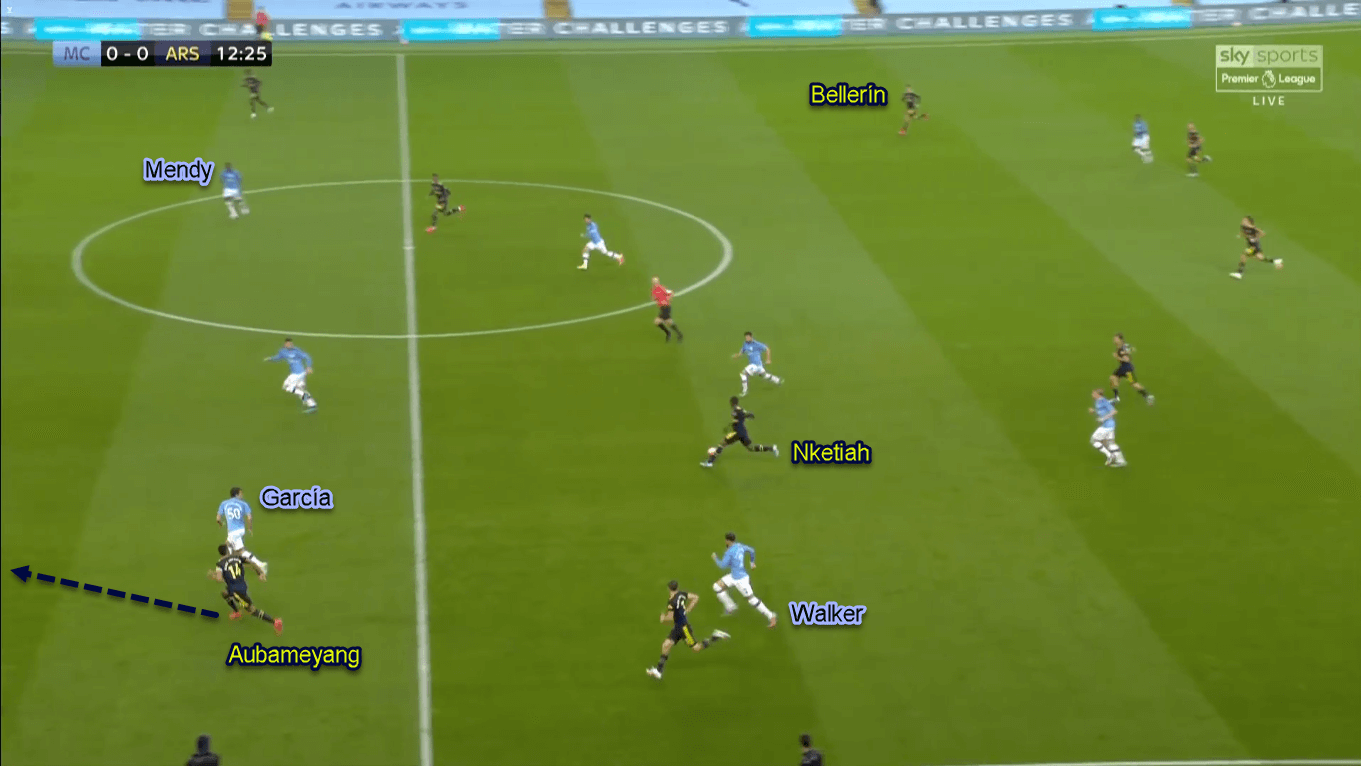
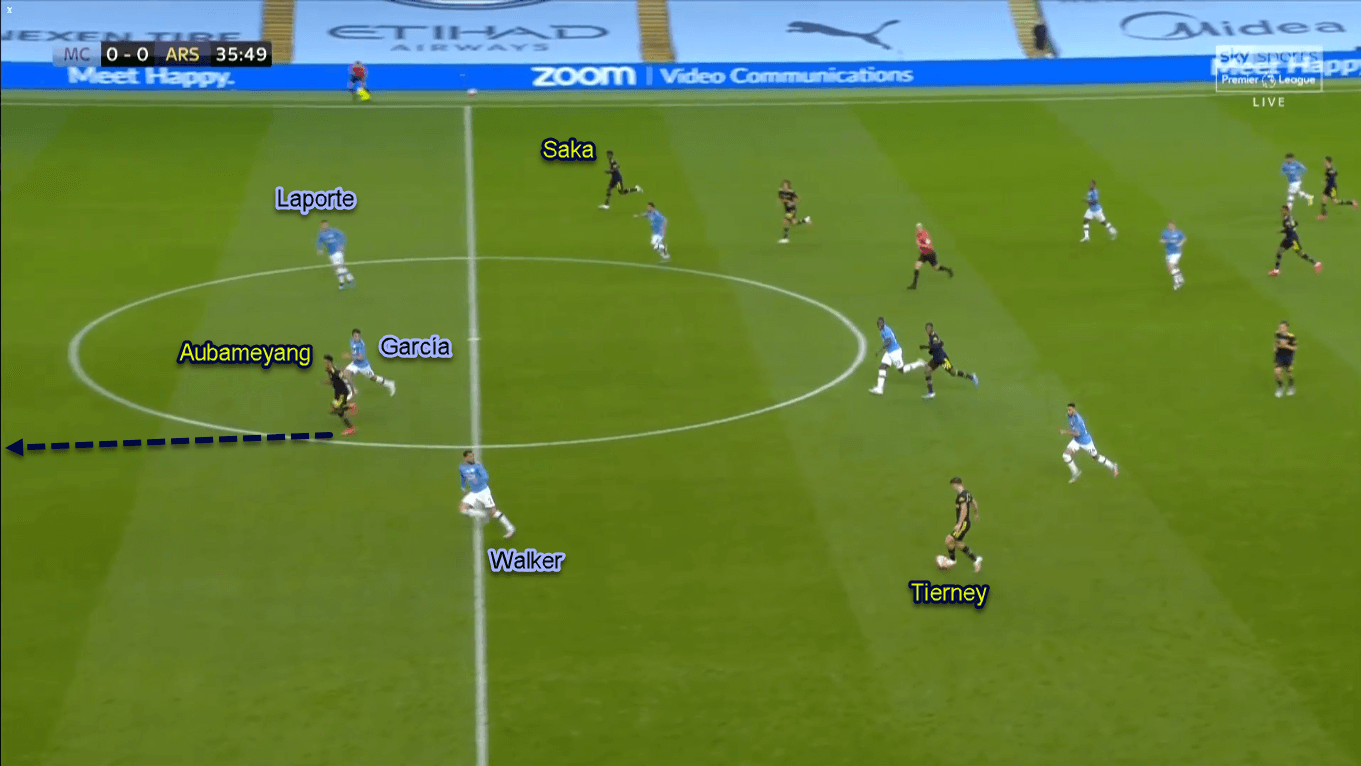
The issue happened also in transitions. Arsenal’s young men were more inclined to pick safe passes rather than serving Aubameyang. Sometimes they even opted to deploy a diagonal ball to the far-side winger; further underlining a decision-making issue. This is probably why Arteta was raided questions about his decision not to play limitless-passing-range Mesut Özil.
Let’s return to the chess game
As mentioned previously, Arsenal did enjoy some moments inside City’s defensive line. However, Guardiola reacted to this brilliantly. In the process, he instructed his team to be less aggressive in their pressing game. It means that Leno, Mustafi, and Luiz were allowed more time on the ball than before.
The principle stayed the same, though, as City kept preventing Guendouzi to be accessed. Nevertheless, the application was a bit different. Instead of using Gündoğan all the time, now the task belongs to G. Jesus to close Guendouzi down with his body shape. Behind him, Gündoğan stayed in the midfield line alongside De Bruyne and Silva. The issue between the lines never occurred since.
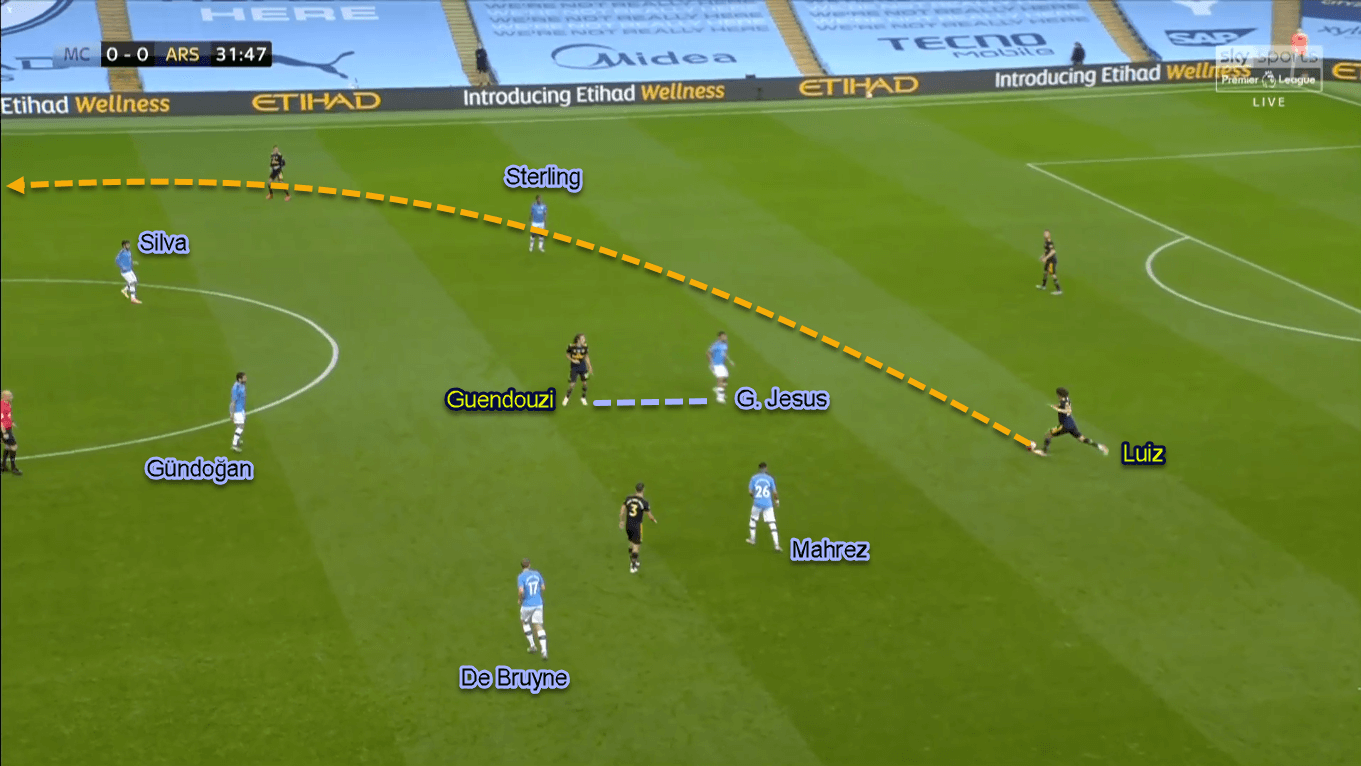
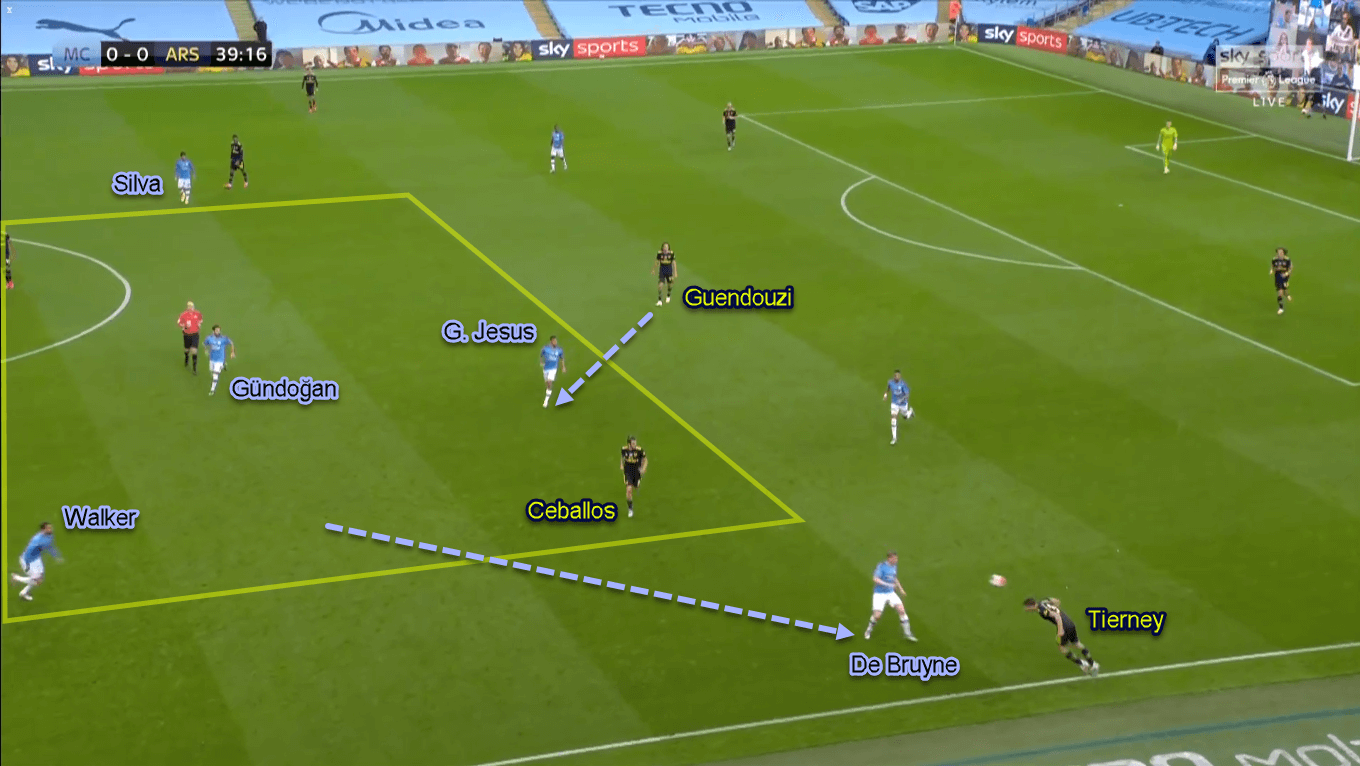
How did Arsenal react? With less pressure from the home side, Arsenal enjoyed more time on possession in their first third. Yet, they still unable to play shortly. Even if they tried to lure De Bruyne or Silva out of their positions, Gündoğan is now there to protect the central space. Again, Arsenal were forced to use long balls with a rather similar outcome. If we look at the stats, Mustafi, Marí, and Luiz combined to make 11 long passes, but only one (9.09%) found a guy in navy blue.
Arsenal’s pressing system
Water is wet, and Guardiola likes to play short. As Guardiola’s assistant for three years, Arteta knew this would be the main theme whenever he needs to face his mentor. The young tactician even managed to cancel out City’s short passage of plays for some times in the first half.
In the process, he deployed a rather high 4–2–3–1 pressing when Arsenal didn’t have the ball. As a centre-forward, Nketiah stood between García and Laporte. He would begin his press when Ederson has picked one of the centre-backs to be played.
When executing the press, Nketiah curved his run; preventing the far-side centre-back to be accessed. By doing so he would also prevent a return ball to Ederson as the on-ball centre-back had not enough space and time to do so. Beside him, the wingers stay inside the half-space. The objective was to keep Arsenal’s inside line protected while keeping a short distance with City’s full-backs. This was important for the wingers because they could press the full-backs down quickly when needed.
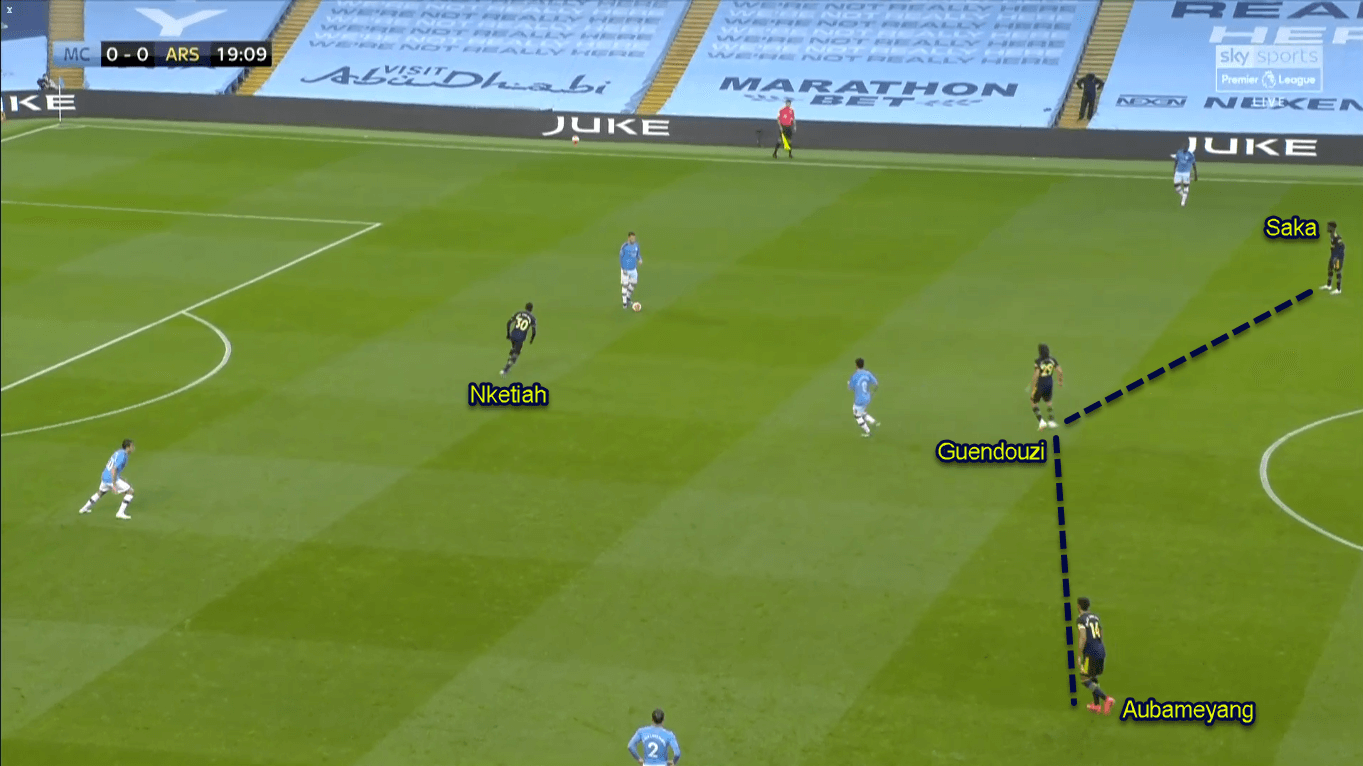
Yet, the most interesting event happened in the midfield. Instead of defending zonally like the forwards, Arsenal’s midfielders were tasked to defend in a man-oriented fashion. Even better, Arteta rotated his midfield in the process. It means that the attacking midfielder Willock switched positions with the right-side defensive midfielder Guendouzi, while Ceballos stayed in his area. This is probably because Guendouzi has a better defensive quality and discipline to close down Gündoğan compared to the young Englishman.
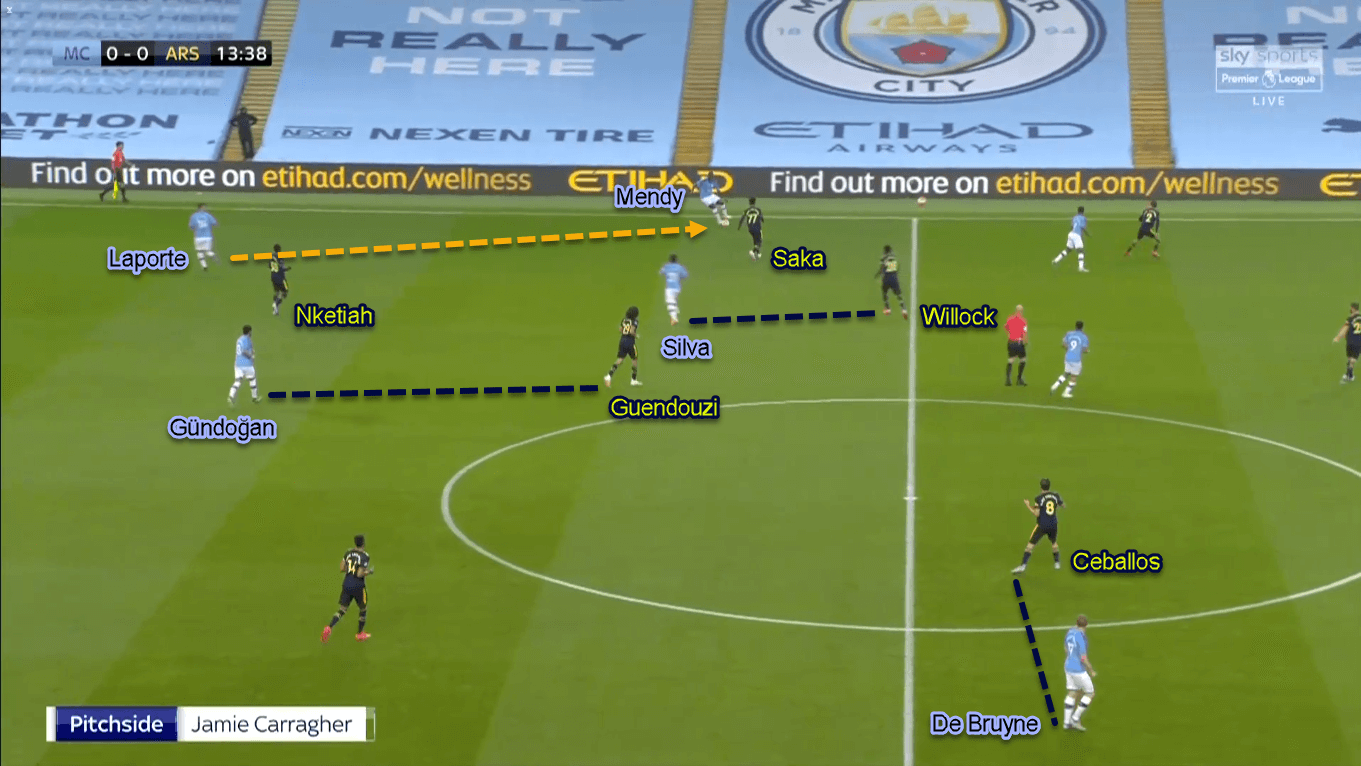
Guardiola’s answer to Arsenal’s press
Guardiola is served with a new problem to solve. Yet, the former FC Barcelona and Bayern München proved his worth by outsmarting Arteta’s pressing game. The main principle Guardiola used was giving his players freedom to move out of positions, thus giving others more or different space to exploit.
First of all, by allowing his central midfielders to drop. In the process, either De Bruyne or Silva would drop from their advanced position(s) to appear alongside Gündoğan. Defending in a man-oriented manner, either Ceballos or Willock would happily follow their man. Unlucky for Arsenal, De Bruyne and/or Silva’s dropping movement was simply a bait to lure their midfielders out of position.
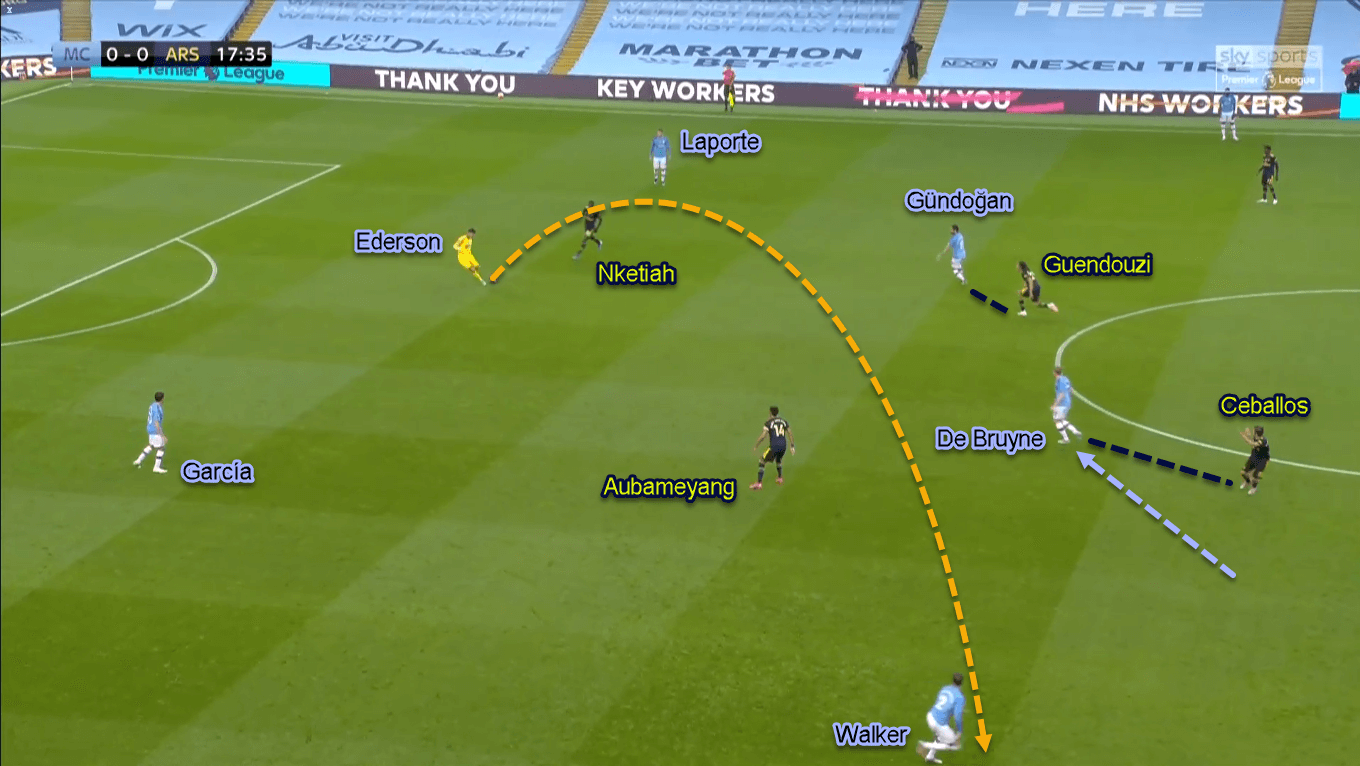
The ‘luring away’ tactic successfully gave City more space in the flank. With an overload at the back — three players against Nketiah alone — City could access the wide-area quite easily. The Citizens could vary their approach either by using a direct ball from Ederson or utilising their centre-backs’ forward passing ability.
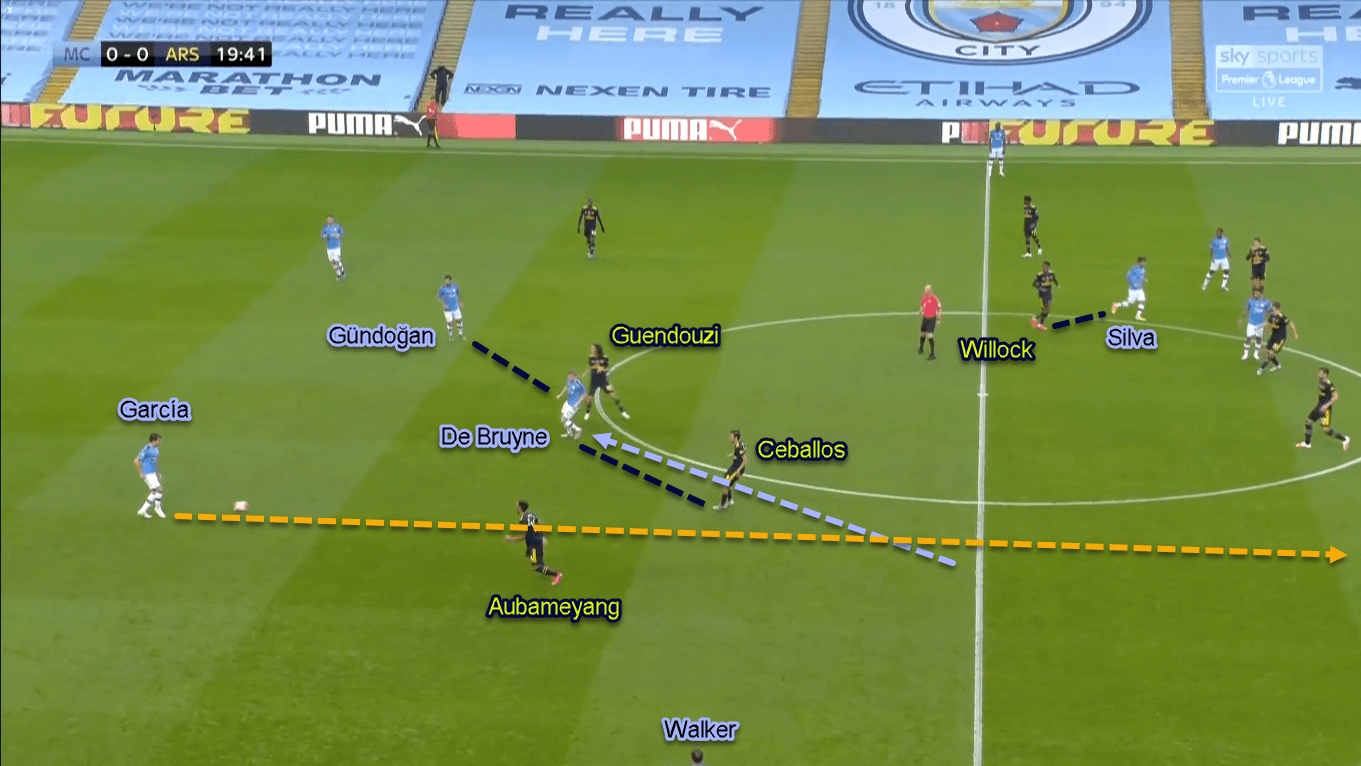
Another important feature in Guardiola’s tactics was allowing his players to switch positions rather freely. Sometimes we could see De Bruyne plays wide as a false full-back, while Walker moves alongside Gündoğan. In other occasions, we could also see Sterling inside the right-side half-space while Silva occupies the left-wing. The objective behind is the same as before: to disrupt Arsenal’s man-oriented midfield, thus opening space in dangerous areas.
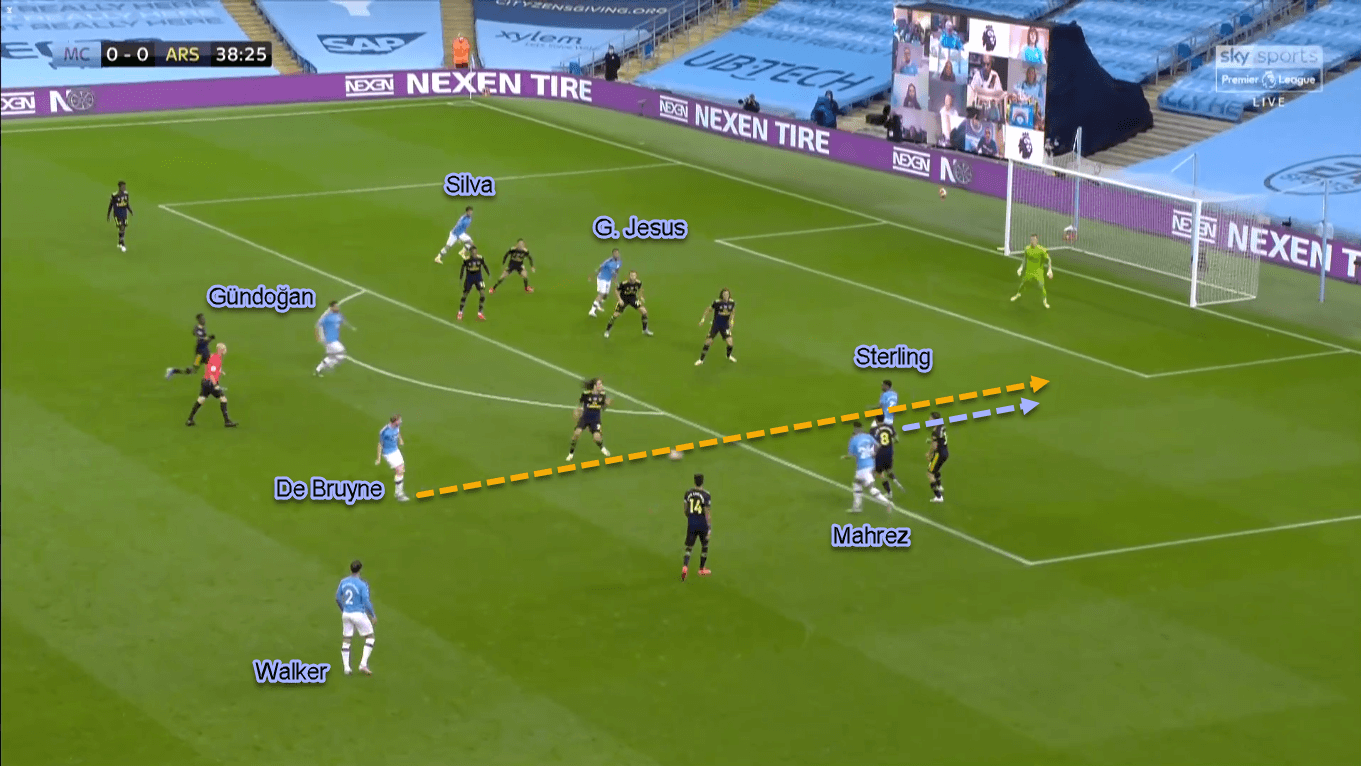
City created chaos from the flank
Moving into more advanced areas, City used more various approach. First, they tried to use Guardiola’s signature: overload-and-switch. To do so, he asked his men to overload the left flank. Sometimes this even made De Bruyne appear inside the same half-space as Silva. After overloading the left flank, City then would try to find isolated Mahrez in the opposite flank. The home side utilised Laporte to try to locate him.
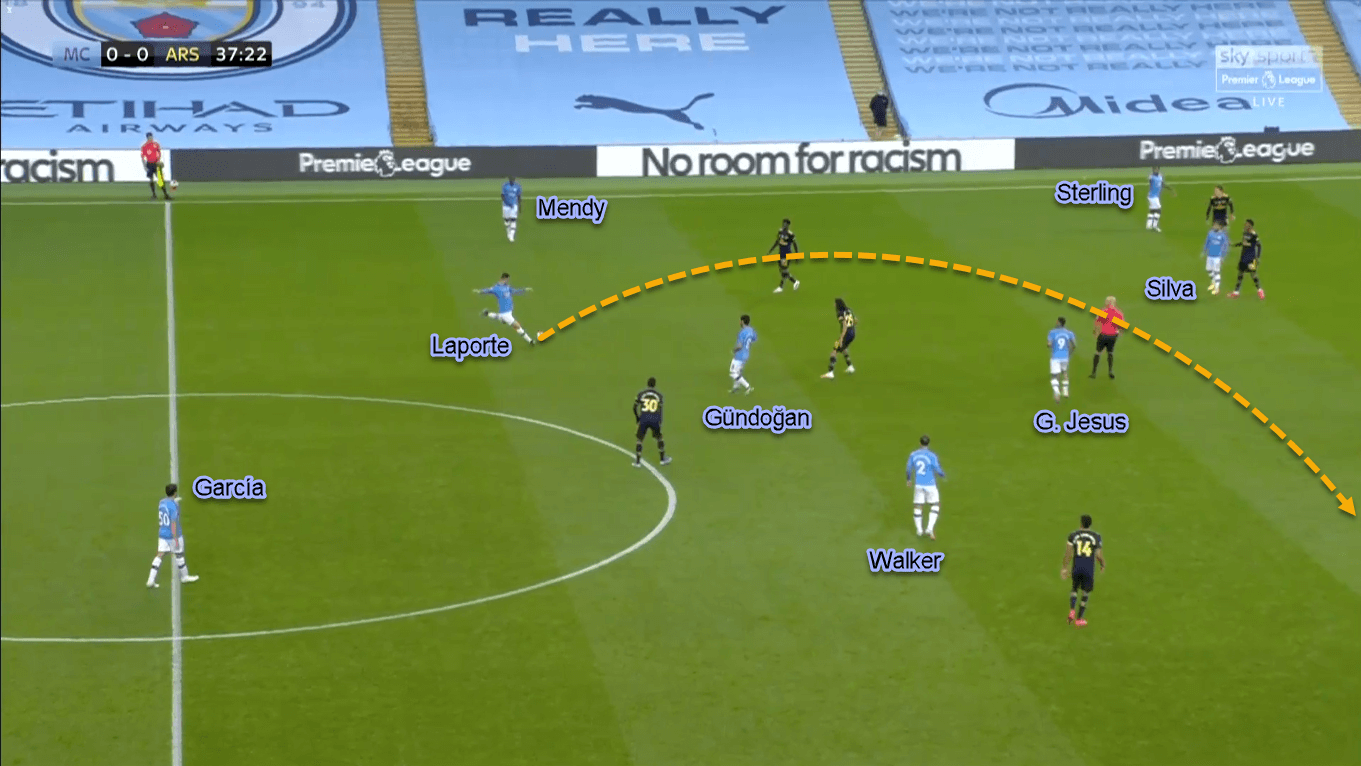
However, Arteta exactly knew Guardiola would use his signature move. He instructed Tierney to somewhat stand closer to Mahrez but still near enough to his defensive comrades. By doing so, this allowed Tierney to prevent Laporte’s diagonal ball more often; thus preventing Mahrez to engage in a one-versus-one duel.
Another way Guardiola utilised was by deploying early crosses in behind. To execute this, Guardiola gave license to De Bruyne to provide the crosses. In the process, he would drift wide — sometimes even to the touchline — before sending his crosses in. To be honest, the Belgian seemed more like a full-back rather than a central midfielder with this particular task.
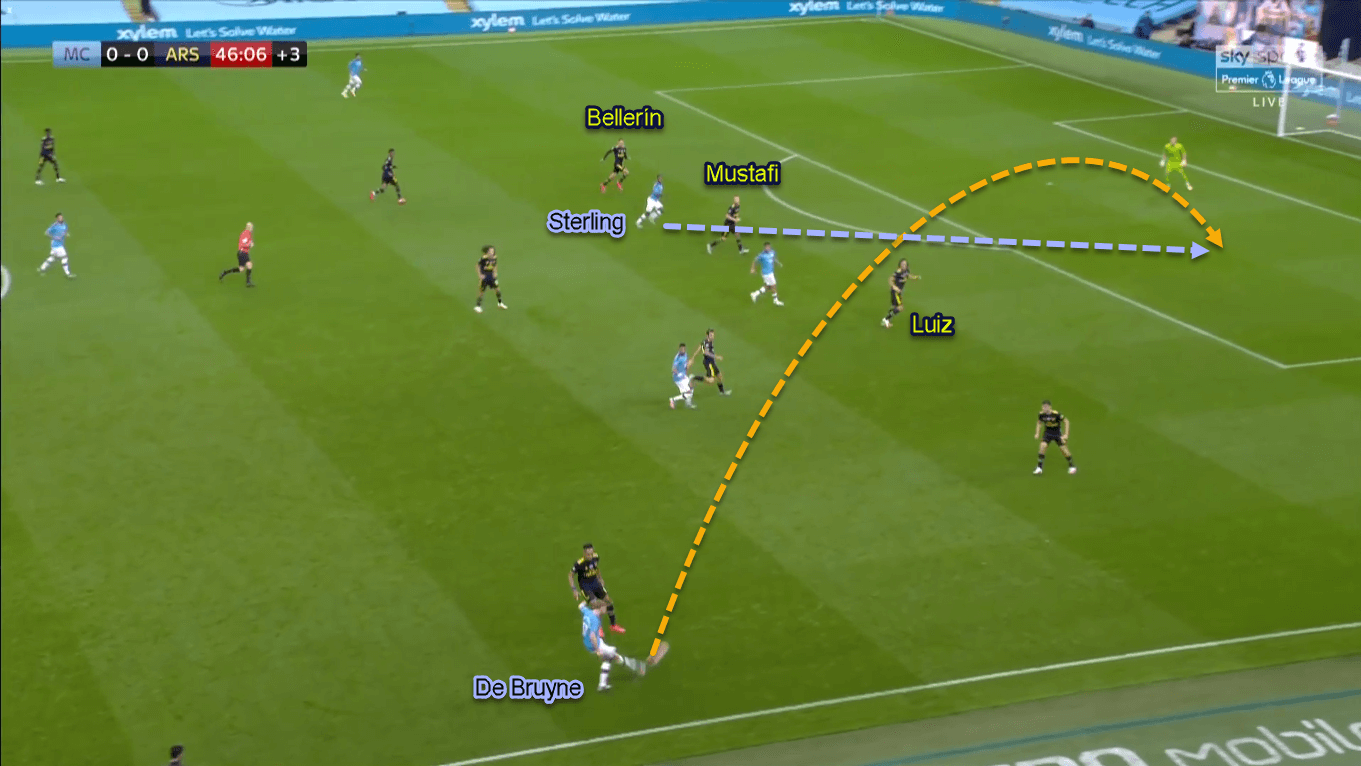
In the final third, either G. Jesus or Sterling could be the target of De Bruyne’s crosses. They would position themselves between Arsenal’s defenders — mainly the centre-backs — when the move is still initiated. Then, they would attack the space in behind from the defenders’ blind-spot. By doing such a chain of movements, G. Jesus and Sterling made them very hard to predict for Arsenal’s backline.
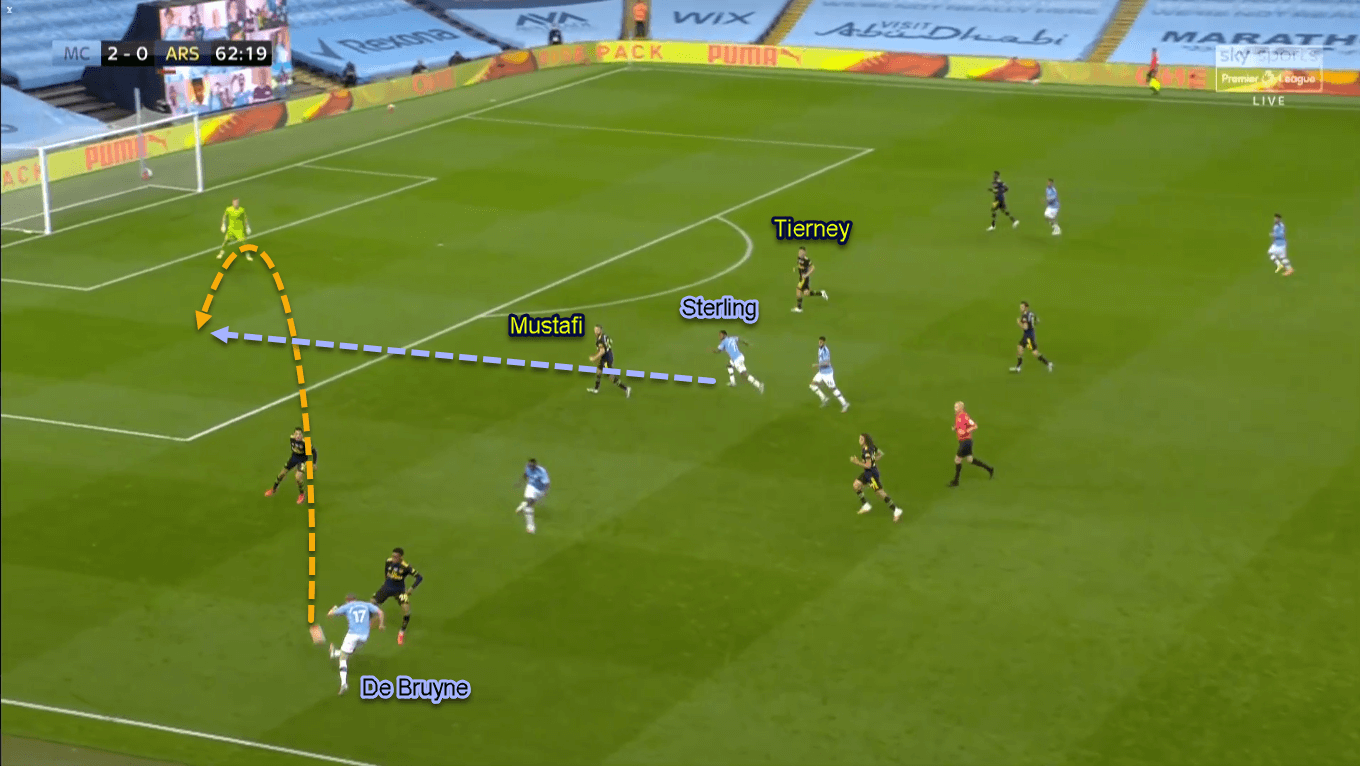
Arteta’s second-half adjustments
Initially, Arteta had a plan for the second half. That was putting Aubameyang more advanced defensively, (almost) in parallel with the centre-forward. The objective was to close García down, even preventing him to receive the ball at all. Yet, it came with a risk. By being positioned more advanced than the midfield line, Aubameyang left Walker completely free. The Gabonese’ advanced positioning also gave more defensive burden for the left-back as there would be bigger space to occupy for him.
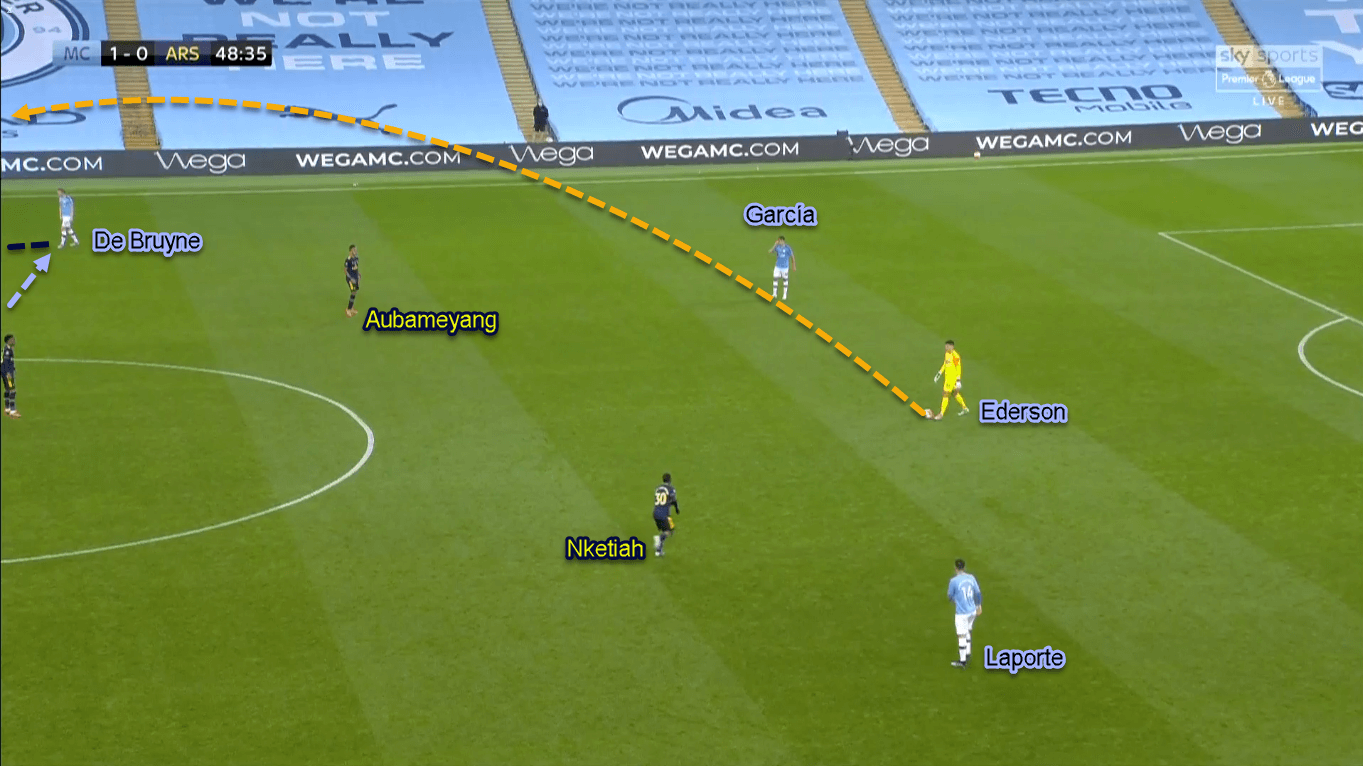
The bad went to worse after Luiz’s expulsion. Indeed he didn’t have an excellent, well … 25 minutes, but it was Arteta who put him in a miserable position. For a fact, Aubameyang was closing on García when Ederson made the long pass. Behind him, De Bruyne has dropped to Walker’s position and pull Ceballos with him. This allowed the Walker — who was supposed to be in Aubameyang’s watch — to bomb forward, win the aerial duel against Tierney and lay the ball to Mahrez.
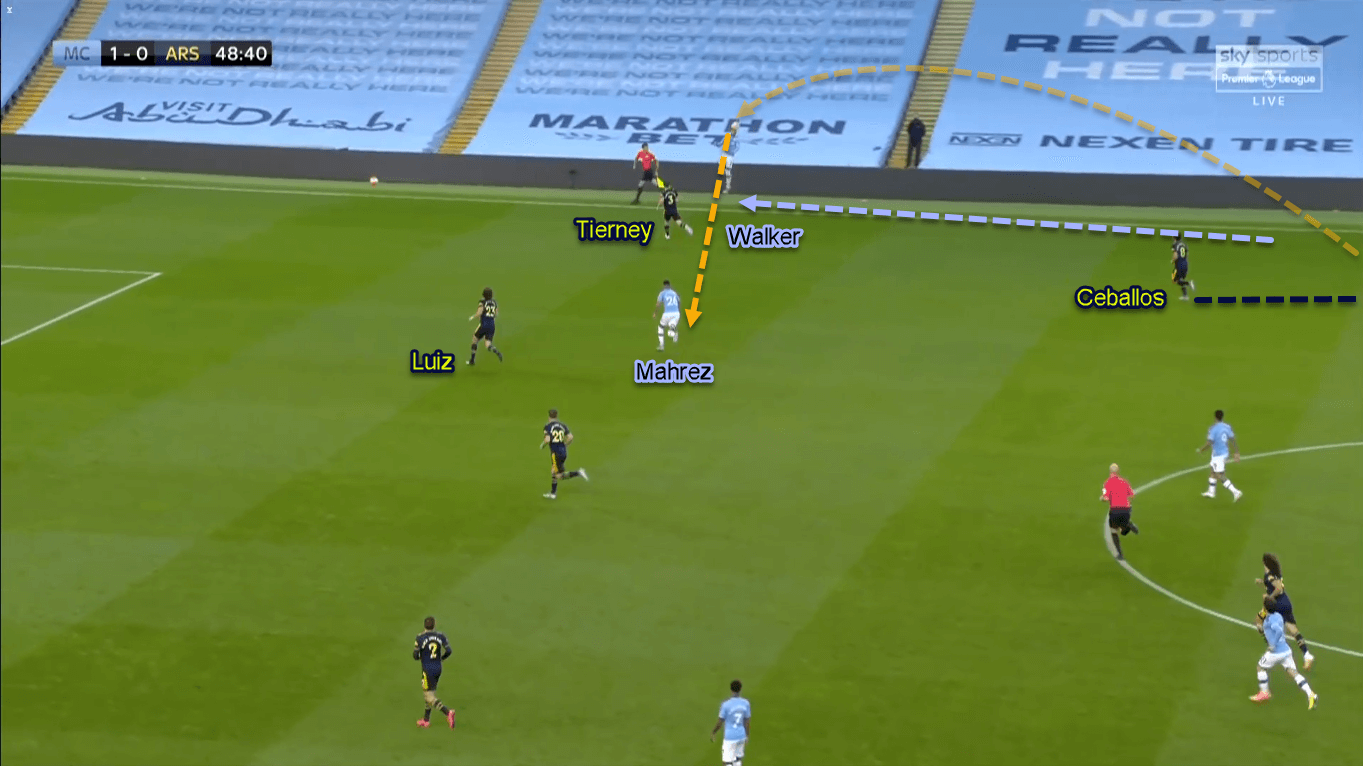
Arsenal moved to a deeper 4–4–1 after Luiz was sent off. In the process, Tierney moved alongside Mustafi while Saka returned to left-back. Having fewer players, The Gunners couldn’t keep with City’s fluid rotation and numerical advantage. Arteta then asked the midfielders to defend zonally — rather than staying in a man-oriented system — to protect the central lanes better. Later, Arsenal moved to a slightly more aggressive 4–3–2 to try to chase the game. However, the right-side issue still existed until the final whistle. For a fact, Foden’s goal also started by exploiting a similar issue.
Guardiola’s second-half adjustments
Having more outfield players was a blessing for Guardiola. It means that his team could pin the opponents deeper, as well as having numerical superiority in more areas of the pitch. Speaking of numerical advantage, City enjoyed this mostly in the midfield.
Previously, Arteta asked his midfielders to defend in a more man-oriented fashion. However, that was not possible in the second half as City would easily overload and overrun Arsenal’s midfield. City did that not just by allowing one of their midfielders to drift but also using G. Jesus to pin Arsenal’s centre-backs. By doing so, neither Mustafi nor Tierney could help their midfielders against the likes of De Bruyne, Gundogan, and Silva.
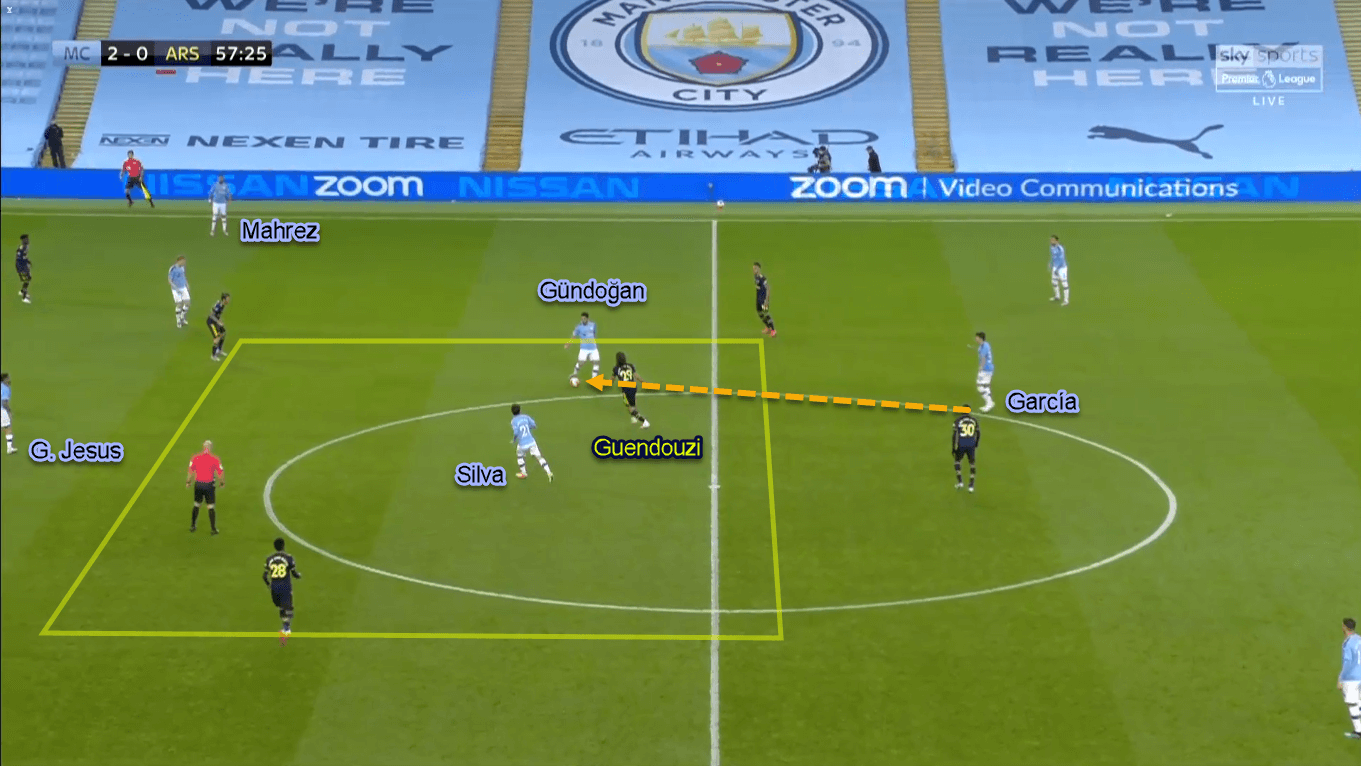
As if it was not enough, Guardiola allowed their men to rotate more freely. Sometimes both Sterling and Mahrez could be found together in between the lines. In other occasions, G. Jesus drifted wide while Silva went higher. Apart from dominating the central area, the objective behind that was also to allow the flank to be completely occupied by City players. From there, the on-ball player could send The Citizens’ signature ground-crosses.
Defensively, City moved to a mid-block 4–3–2 after García’s injury. In this shape, they didn’t press Arsenal’s deeper players as aggressive as before. Instead, the forwards would come close and stay in their line. In the process, City would allow Arsenal to have the ball more often; including Guendouzi, who was completely shut in the first 45 minutes. Yet, Arsenal had not much time and energy left to chase the game.
Conclusion
The first half may seem too boring for some as both teams cancel out each other. Nevertheless, there were so many interesting tactical aspects that can be learned from the opening half alone. For some, it even looked like a chess game rather than a football match. Both tacticians seemed to have an answer to every single movement from their adversary.
All tactics aside, lest we forget about Luiz’s awful performance that changed the course of the game. However, Arteta also played a part with his high-risk tactical adjustments for the second half. A dramatic game indeed, and surely a great tactical battle from Guardiola and Arteta. Welcome back, Premier League!





Comments